
Contact

Home
Loch Ness Monster part 9

1934

continued
That Monster
The Central Queensland Herald (Rockhampton, Qld.)
Date: November 15, 1934
Page Number: 16
ADMIRATION for the Loch Ness monster is turning, in my case, at all events, into commiseration. He has been threatened with a special Act of Parliament for his protection, fate is going to be snapped from the air by cinema artists, and now there is some talk of the Zoological Society organising a special expedition to identify him. It seems a sad thing that even in this age a shy loch monster cannot be allowed to retain his incognito, but have all sorts of unwanted publicity thrust upon him. The most humorous suggestion of all is that a grid should be built right across the weir over which the waters of Loch Ness now run into the River Ness so as to prevent the sea serpent making another successful getaway. There is a simple faith in the monster's actual as opposed to imaginary existence about this that is very pleasing. My own suggestion would be that the Anglers' Association should arrange their next fishing competition at Loch Ness. The situation affords an opportunity that Baron Munchansen would have envied.

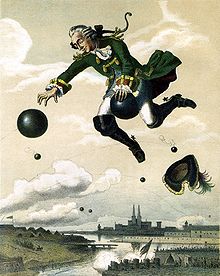

Munchausen rides on a cannon ball.
The Monster of Loch Ness
Not a Porpoise, Walrus or Whale--But What?
A Shy Creature of Many Humps
Sunday Times (Perth, WA)
Date: November 18, 1934
Page Number: 20 S
Discussed at length in the National Parliament of Great Britain; protected by statute; eagerly sought after by natural historians; chased by scores of pressmen; awaited in ambush by equally as many photographers; enthusiastically courted by countless sightseers. That briefly, and almost completly sums up what is known of what is known as "The Monster of Loch Ness."
Many have visited the famous Scottish loch since the "monster's" appearance was first reported. Some have gone there to scoff, and have scoffed. Others have gone to scoff, but have remained to wonder. Very few, however, have succeeded in gaining their ambition of catching a glimpse of the creature. None has seen enough to give a description sufficient to allow scientists to even venture a guess at what it might be.
A Mr. Goodbody, described as a man who "has travelled all over the world," frankly admitted that he put all the talk and reports "down to a Press publicity stunt"—as if newspapers would do such things!—but going to the loch armed with a pair of powerful glasses caught sight of the monster and was surprised to see "that it did not correspond with any of the descriptions which had already appeared in the Press." Mr Goodbody, in good taste, did not add that all previous descriptions had differed materially from one another.
Mr. Goodbody saw the monster for 40 minutes and was well able to say what it was not like. He said: "The object is not anything like a porpoise, or a walrus, or a whale, which have been suggested. In fact, I think that all the guesses made about the monster are wrong. From what I saw of it yesterday, the object, as I have stated, is absolutely different from what I have seen in all my world-wide experience. The small head was perched on a thin long neck, much higher than the body. The part which I could see was at least 16ft. long."
This observer counted no less than eight humps, and his daughter counted nine. The man to whom he told his story was too polite—or perhaps be was not one of the scoffers—to remark that it was certain then that the monster was also not an elusive camel taking a periodic bath.
Mr. Goodbody was certain of one feature. "The creature had a long thin neck with a very small head." So small that he was "terribly surprised."
Several others secured fleeting glimpses of the unknown disturber of waters of the loch and the minds of the more superstitious inhabitants of the neighborhood. Two lady motorists saw it cleaving through the water well out of the loch."
Then two venturesome beings entered the deeps of the loch and dragged out a log of wood. Naturally, the scoffers scoffed heartily. But not for long. The monster was seen again. So, equipped with all the latest devices for cinematography, along to Loch Ness went representatives of a film company.
After a fortnight of fruitless waiting these watchers were on the point of giving up when a commotion was noticed on the surface of the otherwise peaceful waters. Hearts leapt and spines stiffened. All were on the alert. The monster was shot by three cameras. Here is the London "Times" brief review of the cinema film taken:
"That part of the film inn which the monster appears occupies the screen for only a minute or two. The creature is seen swimming towards the right, getting farther away as it travels, and is apparently diving just as it leaves the field of view of the camera.
"There is here no definite evidence of the small, upraised head and long neck to which several eye-witnesses have testified, but the main mass of the body seems to be preceded by a smaller mass, which like the rest is partly under and partly on the surface of the water. The photographers declare that they saw seven or eight humps on the monster's back, and some of these humps are discernible in the film.
"The most clearly evident movements are those of a tail or flukes. This appendage is noticeably darker than the body. The photographers describe the general color of the creature as grey, that of the tail as black. Indeterminate movements of the water beside the monster as it swims suggests the action of something in the nature of fins or paddles."
But the monster ot Loch Ness, like every true and dour Scot, does not always stick to water. A motorcyclist "almost struck it"—a nasty habit that motor cyclists seem to have. Mr. James Grant, who was motorcycling, home in the "wee sma' hours" of one morning reported that "he saw the monster in the bracken by the side of the road. He said he was proceeding on his motor-cycle at about 20 miles an hour and saw the monster about 80 yards ahead of him. It leapt about three yards from the bracken to the centre of the road, landing on what appeared to be four flippers like those of a seal.
"Mr. Grant stopped his motor-cycle and ran towards the creature, which made another leap and landed on the loch side of the road. It then made its way down to the water, which it entered with a splashing noise.
"Mr. Grant describes it as being at least 18ft. long, black or dark brown in color, with a small flat topped head, very large eyes, long neck, and on the back of the body two slightly rounded ridges. The tail, which was well off the ground, was thick and tapering."
Determination is the predominant feature of the resolve of big-game hunter and naturalist, Mr. M. A Wetherall. His keenness is fortified by the finding of footprints of an amphibian on the shores of Loch Ness. Spoor, too, has been discovered: spoor containing the remains of a goat.
And so the search goes on, to the accompaniment of cartoons in home and foreign journals and the burlesquing in processions. It is freely pointed out that "Scotland's monsters are always so very shy" and the flocking of sight-seers to Loch Ness might send the monster more into retirement than ever. All the while the timid and nervous are feeling inclined to implore, "How long, O Lord, how long?"

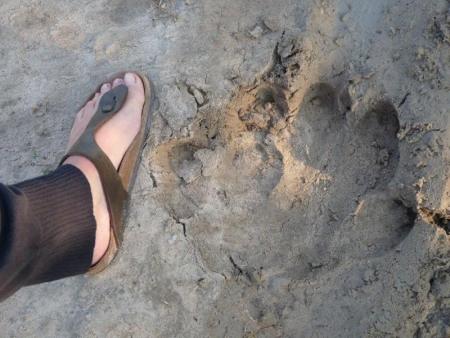
Hippo footprint
The Queenslander (Brisbane, Qld.)
Date: February 22, 1934
Page Number: 40

...
Have you heard of the "Loch Ness Monster," aunt? For some time a huge monster has been seen in this very big loch, and for a time it was supposed to be imagination; but so many people have seen it that the newspapers have an taken the matter up. The creature is anything from 10 to 50ft. long and with a, huge head. It has been seen on land, and its footprints have been measured, photographed, and published in the papers; even the London "Times" has derated columns to the report of a famous investigator. £10.000 has been offered as a prize for the capture of the monster. I wonder if it is all a joke? I told a boy friend yesterday that every time the Loch Ness monster hears the clock strike twelve it comes out of the water, wags its tall, and then goes back again, and the boy failed to see the joke.—"Bodgins" (17), Mapleton, Renfrewshire, Scotland.
...
"Bodgins": It is interesting hearing your story of the Loch Ness Monster, Monty, for of course we had cable about it—and, naturally, jokes.
...
The Central Queensland Herald (Rockhampton, Qld.)
Date: February 22, 1934
Page Number: 16

CAPTAIN BERTRAM MILLS, of circus fame, is not the only person who has gone to Lloyd's about the Loch Ness monster. He has taken out a policy covering three weeks against the possibility of the monster being captured. Another similar policy, held by a Scottish concern, is against the monster being discovered and established as an unknown species of prehistoric beast. I have no notion what the amount pf premium is, but I should think, myself it was a very safe bet by Lloyd's. This is a novel kind of business even for Lloyd's, who will insure most things, inciting the riak of twins, but, if the monster epidemic spreads a little more, it might develop into quite a good line of business. Most people are firmly persuaded that, if there is anything at all out of the ordinary in Loch Ness, it is nothing more sensational than a couple of adventurous seals on a honeymoon trip.

Bertram Wagstaff Mills
(August 1873 – April 16, 1938)
was a British circus owner who ran the Bertram Mills Circus.



Advocate (Burnie, Tas.)
Date: February 22, 1934
Page Number: 2

A special representative of the "Scotsman" who was sent to Loch Ness to trace and, if possible, to capture the mysterious visitor, tells a story which is almost convincing — quite convincing enough, apparently, to fill every hotel and guest-house within miles of the now world-famous loch. He spent days roaming up and down the shores of the long strip of water, and in that time he found a hundred people who claimed to have seen the unnamed animal, or fish, or whatever the creature is. Not one of the hundred was associated with a distillery.
Having interviewed scores of eye-witnesses, he made a sketch of the monster as they described it. It is greyish-black in appearance, and is rough and mottled. There are two humps, one larger than the other, and a neck which extends for several feet. The length from the head to the end of the second hump was said to be between 15 and 20 feet, but observers were satisfied that more than half the monster was submerged, and therefore invisible. The creature dived on hearing a motor horn, and left a heavy wash.
The "Scotsman" representative neither captured nor saw the monster, but latest advices show that Loch Ness hotels are still doing capacity business.
LOCH NESS MONSTER
IS IT A SEAL?
The Argus (Melbourne, Vic.)
Date: February 24, 1934
Page Number: 10

(From Our Correspondent)
LONDON, January 25.—Seldom has a sea-serpent enjoyed such long-continued public attention as the monster of Loch Ness, which has persisted for six months. Sedate newspapers have despatched special correspondents to the Highlands, and the Secretary for Scotland has placed five constables on duty to protect the creature should it appear. None of the constables has seen the sea-serpent, but a photograph has been published, which the public has accepted as equally vital evidence. Unfortunately, the exposure was made by a cinema agency at a distance of 200 yards, so the scientific world has remained sceptical. The flrst newspaper reproduction was hastily withdrawn on the day after publication on the ground that the print had been "slightly retouched to throw up the details of the monster and its shadow." An expert who has examined the original negative has come to the conclusion that the object shown' represents no animal known to science, and, moreover, that it was not photographed at a distance of 200 yards as stated. As for the,'"spoor" of the monster, which other investigators found on the muddy shores of the loch, zoologists at the Natural History Museum decline to take them seriously. Accepting the evidence of eye-witnesses, the creature might be a large eel, a grampus, a white whale, a porpoise, an otter, a sunflsh, a crocodile, or a Plesiosaurus. In view of such a multitude of possibilities, the zoologists make no decision.
The real Interest of the Loch Ness monster is not zoological, but physchological. Socrates once asked Strepsiades, "Did you ever look up to see a cloud like a centaur, a wolf, a bull, or a leopard?" The unsuspecting Strepsiades replied, "By Zeus, I did. But what of that?" "Ah," replied Socrates, "they become what they will!" The tales from Loch Ness have the same variety. Some observers saw an eel-like monster with a humped back; others something that looked like an overturned boat. Mr. Arthur Grant, a veterinary surgeon, was cycling along the north side of the loch when he came upon the monster in the road. It took two great leaps and disappeared into the water. "A hefty body, with flippers," was Mr. Grant's impiession. Mr. Goodbody and his two daughters examined the creature through field-glasses at a distance of 500 yards, and counted no fewer than eight humps, not to mention a long, thin neck and a very small head. Mr. Alistair Bisset describes the creature as resembling a sub-marine. As Socrates said of the cloud forms. "They become what they will." Dwellers about Loch Ness are still convinced that a most unusual creature has found its way into the lake, but science will not admit more than the possibility of a grey seal. The species breeds about the Orkney Islands, and it is not uncommon in Moray Firth. It is just possible that a grey seal has been washed from the open sea into Loch Ness.
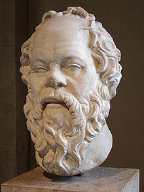

Socrates

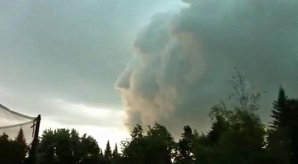
Pareidolia is a psychological phenomenon involving a vague and random stimulus (often an image or sound) being perceived as significant.
ANOTHER SCOTTISH MYSTERY.
Sunday Times (Perth, WA)
Date: March 4, 1934
Page Number: 8 S

Despite the excitement in Scotland over the discovery of a monster in Loch Ness the peculiar behavior of motor vehicles and cycles on a stretch of road nine miles south of Ayr is causing considerable interest. Briefly, vehicles coast up hill on this road and stall on the down grade, to the amazement of motorists and others, who find their machines doing exactly the opposite of the expected. Local superstition stoutly supports a magnetic theory as the explanation of the phenomena, but others, more sceptical, maintain the "up hill coasting and down hill staillng's purely imaginative, the result of optical illusion."
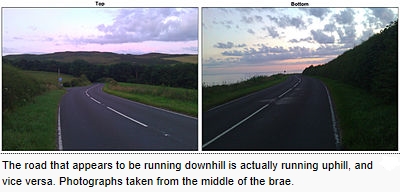

The Electric Brae is a gravity hill in Ayrshire, Scotland, where cars appear to be drawn uphill by some mysterious attraction. TheLowland Scots word brae means a hill-slope or brow (with which it is cognate), and the "electric" name was given when electricity
was a new technology associated with strange forces.
There are hundreds of gravity hill locations around the world - see list
of gravity hills. The explanation often given for the phenomenon is that of a visual illusion, similar to the well-known Ames room,
in which balls can also appear to roll against gravity.
Loch Ness Monster Tickles the Palate
Sunday Mail (Brisbane) (Qld.)
Date: March 4, 1934
Page Number: 1

PERTH, March 3.
ACCORDING to Mr. J. Gardiner, who returned yesterday from a visit to England, the Loch Ness monster has inspired a new dish, which, while it may not attain the longevity of the Peche Melba, is promising well. It is called "Le Filete Sole Loch Ness."
IT was evident that hours of planning had gone towards perfecting this delight for gourmets, said Mr. Gardiner. A fearsome-looking beast appears on the dish. Its body is half at potatoe in its jacket and along the top is the fish in a series of curves and bumps. Its head is a walnut, with two beady eyes, lobster's whiskers, and lobster's claws, two aside, stuck out in formidable fashion.
Its red tail also once belonged to a lobster, and it swims in green sauce. "Voila, monsieur," said the head waiter proudly, ''it swims in its loch."
Great ceremony attended the inaugural appearance ol the dish. Head waiters, managers, chefs, and page boys appeared, and the monster was borne in with a flourish of napkins, but do not ask what are the ingredients of the sauce. Restaurateurs guard a secret like that with their lives.



Contents



























